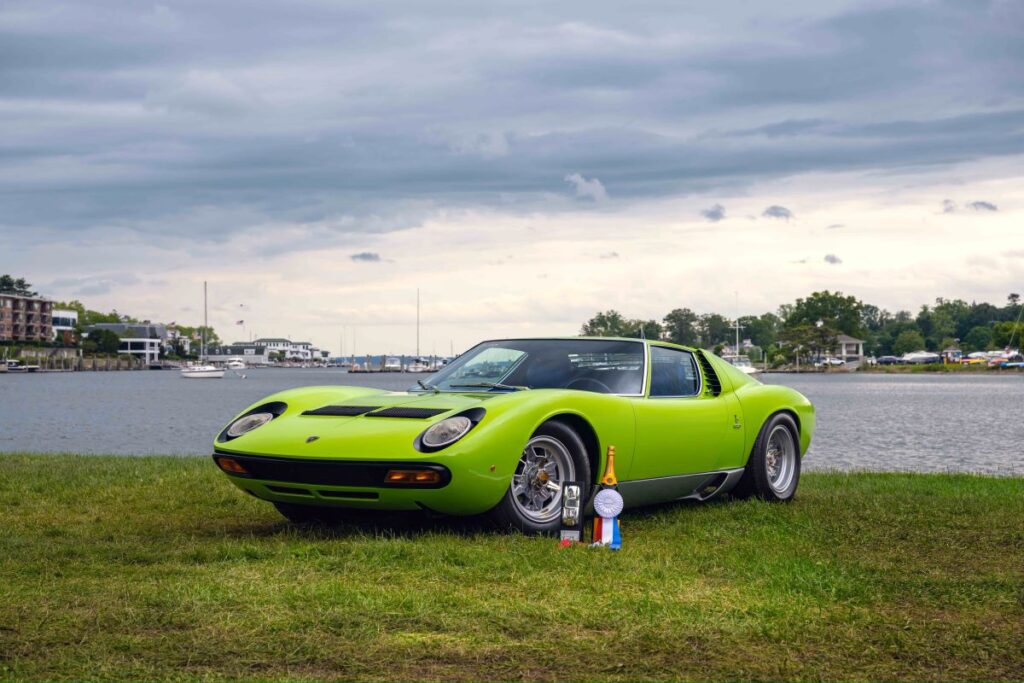
GREENWICH, Conn. (May 31, 2025) – A 1972 Lamborghini Miura P400 SV cut a neon slice through the gray skies above the 2025 Greenwich Concours, motoring across a sodden lawn to receive its Concours de Sport Best in Show award. The Miura entered as part of the Mid-Engine Revolution class. It edged out its 1970s rival, a 1979 Ferrari 512 BB that finished runner-up in Best in Show judging.
The final Miura delivered to the United States, chassis 5064 was special-ordered and imported for an ex-WWII Air Force pilot named George Rosen of White Plains, New York. Alfredo Pedretti’s Modena Racing Co. handled delivery, and period documents show a final price of $23,400 (about $179,000 today).
The car was subsequently owned and restored in 1980 by Lamborghini factory driver and chief development engineer Bob Wallace. The original paint was white. Around 2000, it received its Verde Chiaro (Clear Green) and contrasting blue interior in the hands of respected Miura restorer Gary Bobileff, before selling to its current owner, Lawrence Auriana, in 2003.
Auriana is a known and respected collector of vintage Italian sports cars. “My collection is a tribute to the contribution of Italy to the automotive industry,” he said at Amelia Island in 2015. “It’s much more than the red cars from Marenello. It’s the red cars from Modena, the red cars from Milano, Torino. It’s Abarth, Moretti, Stanguillini… My cars are a tribute to a group of Italians that made an important contribution to the automotive industry in the 20th century, the great designers, engineers, and sportsmen who raced these cars.”
The Miura is widely considered the world’s first true supercar. Launched as a bare chassis at the 1965 Turin Motor Show, the still-nameless vehicle caused a stir with its transverse, mid-mounted 4.0-liter V-12 and transaxle. The response it elicited prompted Ferruccio Lamborghini to initiate the car’s production. He hired Marcello Gandini to design the elegant monocoque body, which remains among the most beautiful cars ever made for series production.
Like any high-performance Italian car of the era, it had quirks. For one, the nose had a tendency to lift at about 100 mph. The transaxle design was chosen for its packaging advantages, but it also included a common oil supply for the engine and transmission, which didn’t permit a limited-slip differential. When the P400 S landed for 1969, it brought power windows, vented brakes, an updated rear suspension design, new tires, and an increase from 350 to 375 hp.
The SV, new for 1971, refined these changes further into what many consider the ultimate Miura. Upgrades included a fix for the nose lift issue, a power bump to 385 horsepower, more rear suspension improvements, and—for later cars—a split case that allowed for a limited-slip differential. The headlights notably lacked the black trim, famously nicknamed “eyelashes,” from the early cars.
Chassis 5064 came specified from the Lamborghini factory with optional air conditioning, a steering lock, and hexagon nuts for center bolts as required by U.S. regulations.
Bob Wallace, when he restored Miura 5064 in 1980, upgraded the car with several “J” or “Jota” specifications that mirror those he added to a Miura test mule in 1970 to pass FIA J racing rules. For chassis 5064, those included a seam-welded and reinforced chassis, uprated brakes and suspension, a deeper sump with baffles, lightened reduction gears with hard-chromed pins, independent transfer gear oilers, teflon-sealed oil intake guides, a full-flow oil radiator (in place of the A/C condenser, which was relocated), and breakerless electronic ignition.
“Everything down to the knock-offs is original,” says Joe Calasacco, director of automotive operations for the Auriana collection. “Except for the rubber, of course.” In addition to maintaining the collection’s cars, Calasacco also races them.
Calasacco accepted the Concours de Sport Best in Show award on Mr. Auriana’s behalf. “The Miura is a stunning car with great lines. And it really changed the landscape in the 1960s.”
When a row of pyrotechnic sparklers went off behind the show stage, in celebration of the winner, it took Calasacco a second to realize the smell of smoke was not cause for concern. “Well, it’s good to see the flames were coming from there and not the car.”
He also noted how Lamborghini and Ferrari had their battles in the 1970s, comparing that rivalry to this concours win over the also-beautiful Ferrari 512 BB with which it shares its class.
Ken Gross, chief judge at the 2025 Greenwich Concours, has his own perspective on the Miura’s significance. “People will tell you all this business about the first supercar and whatnot. For me, the brilliance of the Miura is the trio of 30-year-olds—Giampaolo Dallara, Paolo Stanzani, and Bob Wallace— who Ferruccio trusted to not only match but in some ways succeed Ferrari.
“This winning SV is perfect. Flawless,” Gross raved. “The color combination is an acquired taste, but vibrant colors were part of how Lamborghini differentiated itself from Ferrari. It was a magic car then, and it’s still magic.”
Story by Eric Weiner
Photo courtesy Andrew Link
Leave a Reply
You must be logged in to post a comment.